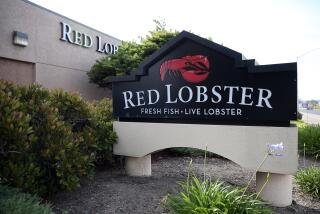Lobstermen Facing Rough Seas, Bad Weather--and Bad Times
- Share via
BAILEY ISLAND, Me. — Jon Rogers’ boat, the Amanda Marie, rocks in 4-foot swells as he hauls a wire trap from the sea and pulls out half a dozen lobsters, their tails flapping and shells glistening.
Like his father and grandfather, Rogers has grown accustomed to lobstering in rough seas and bad weather. But these days, he and other lobstermen along Maine’s 3,000-mile coast are buffeted by more than the elements.
Their profession, their way of life, some lobstermen and dealers say, is in crisis.
Maine seems synonymous with lobstering. The lobster adorns state license plates. Roadside stands sell lobster lawn ornaments with arms that spin in the wind, and tourism brochures feature romantic scenes of wharfs piled high with wooden traps or bearded fishermen pulling lobsters from crates.
The lobster, for better or worse, is part of the state’s psyche. Now, at least, it’s for worse.
“I’m wondering if you’re going to start seeing boats for sale and people going out of business,” said Pat White, a lobsterman from York. “I don’t want to be the voice of doom, but I don’t see next year as being any better.”
“People are losing money in this industry,” said David Dow, a former lobsterman who now heads the University of Maine’s Lobster Institute.
“The profits aren’t there for the harvesters and the profit margins aren’t there for the dealers. They’ve extended credit to the limit for their customers, and some of their customers have gone belly up. They’ve lost millions and millions of dollars. The industry is really struggling with how to cope with these peaks and valleys.”
The turmoil is forcing many lobstermen and dealers to change the business and fishing traditions they have inherited.
Some lobstermen, like Rogers, now market their catch directly to large wholesalers instead of selling it to the local wharf buyer. By doing that, they can increase the price they’re paid per pound.
And Maine’s largest lobster dealers are expanding their sales territories--not just beyond the Northeast, but to Europe and Asia.
“Fishermen can no longer rely on doing business the way it’s been done for generations,” said William Brennan, commissioner of the state Department of Marine Resources. “It’s a changed industry from when their grandfathers went lobstering. You have to promote your product, you have to advertise.”
But the changes have created tensions.
“Twenty or 30 years ago, the fishermen would fish, the buyers would buy the lobsters and sell them to the dealers, and the dealers would sell them to the large city markets,” said Pete Larsen, president of Atwood Brothers Inc., a large dealer based in Tenants Harbor.
“Now the chain has become fragmented and you have the harvester, the fisherman, selling direct to the small stores or even to the consumer. It’s become a real free-for-all. There’s a lot of hard feelings.”
Maine has an estimated 3,000 full-time lobstermen and another 3,000 or more people who fish for the crustaceans part-time. They make an estimated $20,000 to $60,000 annually, depending on the season and how much they fish.
“It used to be everyone had the attitude, ‘If you don’t invade my territory, I won’t invade yours,’ ” said Rogers, 33, a third-generation lobsterman on Bailey Island, located on Casco Bay north of Portland.
“But this fall, it seems like all that’s been thrown out the window. . . . You’ve been fishing in one area all your life and then one day you go out and find three boats there and you’re bumped. It creates hard feelings.”
Over the last two years, the lobster industry has fallen prey to that most basic of economic villains: oversupply and low demand.
Canada is the world’s largest producer of North American lobsters, harvesting an estimated 95.2 million pounds in 1989. By contrast, U.S. lobstermen caught 52.9 million pounds that year, most of it in New England.
Maine is the nation’s largest harvester, supplying about 45% of the U.S. total, followed by Massachusetts and Rhode Island.
Last year, Maine lobstermen caught 27.8 million pounds, breaking a 101-year-old record, according to the National Marine Fisheries Service.
Although the haul set a record, the yearlong average of the price lobstermen were paid for their daily catch--the boat price--sank to $2.15 a pound, the lowest since 1981.
For the last two years, the huge supply has depressed wholesale and retail prices because the U.S. market wasn’t big enough to absorb so much lobster, particularly at the start of a recession. In southern Maine, for instance, retail lobster prices stood at $2.39 a pound for most of September, and at one point dropped as low as $1.99 a pound at some stores.
At times this last summer and fall, the boat price dipped to $1.75 a pound in some areas. And fuel and bait costs kept rising.
In some coves along the coast, lobstermen staged work stoppages to protest the low prices, complaining that lobster, often regarded as a symbol of luxury, had become as cheap as chicken.
“Expenses are at an all-time high and everybody’s feeling the crunch a little bit more,” Rogers said. “People are frustrated with coming in and having the price $1.75 day after day after day.”
Lobster dealers are struggling as well. Many have been hit with bad debts from their customers.
“Their exposure for bad debt risk is extremely high,” said Neal Workman, chief executive officer of SeaFax Inc., a Portland-based credit rating and collection agency for the seafood industry. “It’s about twice what we see in other areas of the seafood industry.”
Several times this summer, Loyall Sewall, a dealer from Bremen, said he had to tell his lobstermen he couldn’t buy their catch for a few days because he had too many unsold lobsters.
“At one point, I had 100-and-something crates of lobsters that I couldn’t sell for what I paid the fishermen for it,” Sewall said. A crate holds about 90 pounds of lobster.
“I think the lobster industry is definitely in a crisis situation,” he said. “It’s not from a lack of lobsters--frankly, there are too many damn lobsters. It’s from a lack of markets.”
Sewall is chairman of a committee of lobster-industry people putting together a legislative proposal for the state to become more involved in promoting lobsters worldwide.
The proposal calls for imposing a surtax on lobster licenses. The money would be used to take out advertisements in seafood magazines, set up booths at seafood shows and for other measures to promote Maine lobsters.
Maine’s largest dealers also are expanding overseas.
Five have formed a new company, Maine Lobster Exporters Inc., to try to create new markets for lobster in Asia. The group has set up a shop in Hawaii, six minutes from the airport, with a holding tank for lobsters.
They’re shipping about 4,800 pounds a week to the island state, to be sold there or divided into smaller shipments for customers in Singapore, Hong Kong and other Asian cities.
“These guys used to fight one another and try to steal each other’s customers,” said Dow, of the Lobster Institute. “Now, we’re seeing them working together.”
Finding new markets is the best solution to the industry’s problems, Dow said.
“This is not a pretty business to be in right now, and it’s being felt from top to bottom,” he said. “We’ve got to find some creative ways to address these problems. For my money, it’s jumping into this globalization of the market.
“We’ve got the king of seafood. Now let’s put him back on the throne.”
More to Read
Sign up for Essential California
The most important California stories and recommendations in your inbox every morning.
You may occasionally receive promotional content from the Los Angeles Times.













